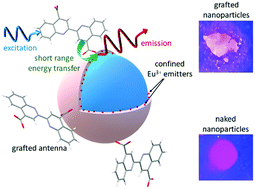Lighting up Eu3+ luminescence through remote sensitization in silica nanoarchitectures†
Abstract
Hybrid organic–inorganic luminescent lanthanide-based nanomaterials are currently attracting great interest for a variety of applications from bioimaging/sensing to optics and photonics. Herein, we present a concept model system based on purely silica-based core–shell nanoparticles (NPs), where luminescent Eu3+ ions are confined to a thin silica layer and are efficiently remotely photosensitized through an antenna unit covalently grafted on the surface of the outer shell. The obtained core–shell NPs, synthesized through mild sol–gel methods, are of rare quality in terms of size distribution, homogeneity and smoothness of the coating shell, the absence of core-free silica, and dispersion of the dopant phase. Convenient indirect optical pumping through the remote photosensitizer allows a remarkable intensity enhancement of the Eu3+-based NP luminescence by 190-fold with respect to that achievable upon direct metal excitation, yielding the highest intrinsic (ΦEu = 49%) and overall (Φ = 19%) quantum yields and ligand-to-metal sensitization efficiency (ηsens ∼ 40%) reported so far for Eu3+-based remotely sensitized organic–inorganic nanosystems. These performances are achieved thanks to the suppression of unexpected nonradiative decay channels pertaining to the silica matrix as revealed by an in-depth analysis of the temporal dynamics of Eu3+ emission upon direct and indirect excitation. These results show that silica matrices are a suitable highly performing host alternative to commonly investigated nanocrystals such as fluorides for the development of lanthanide-based luminescent materials with the additional potentiality of high processing versatility through well-established sol–gel chemistry methods.



 Please wait while we load your content...
Please wait while we load your content...